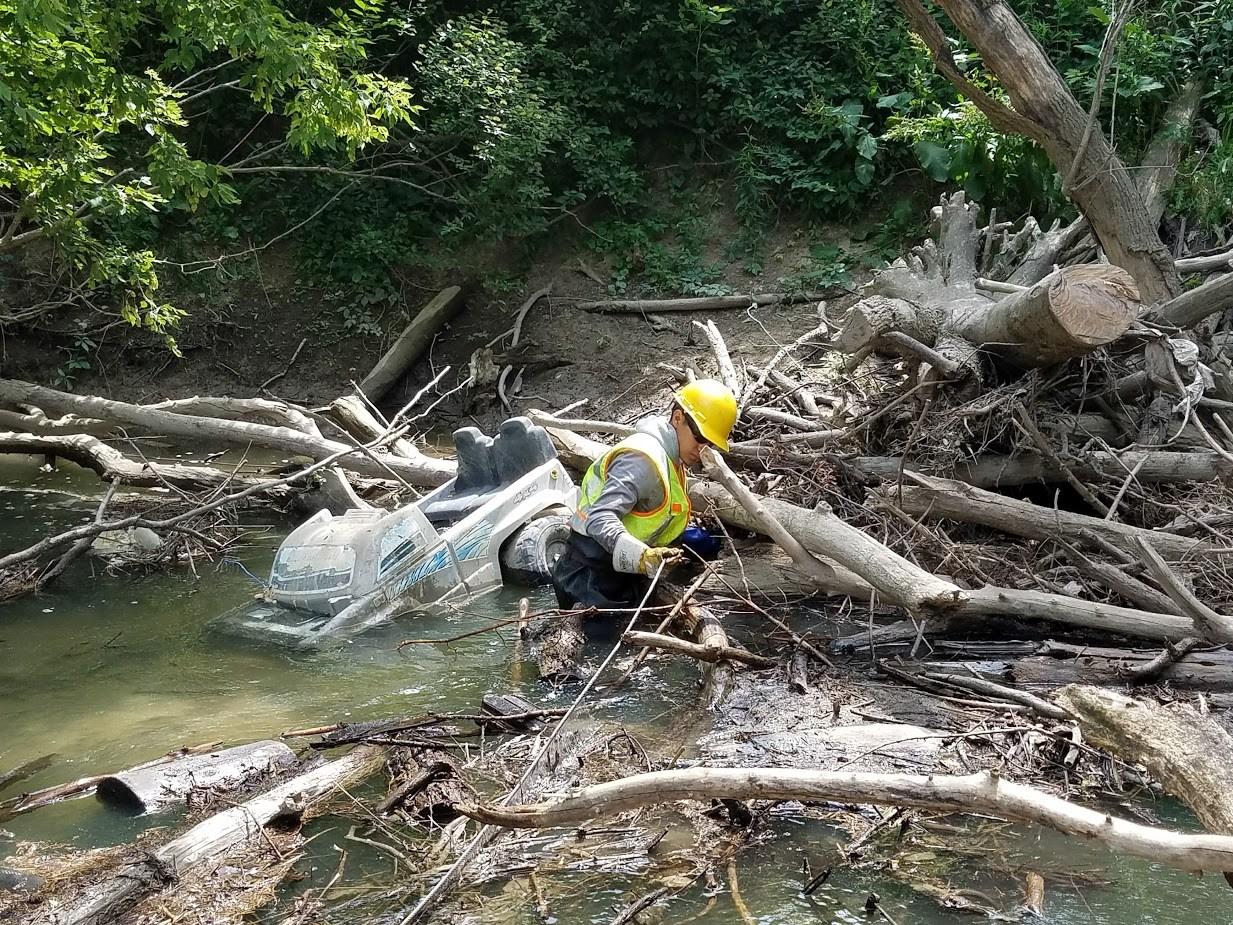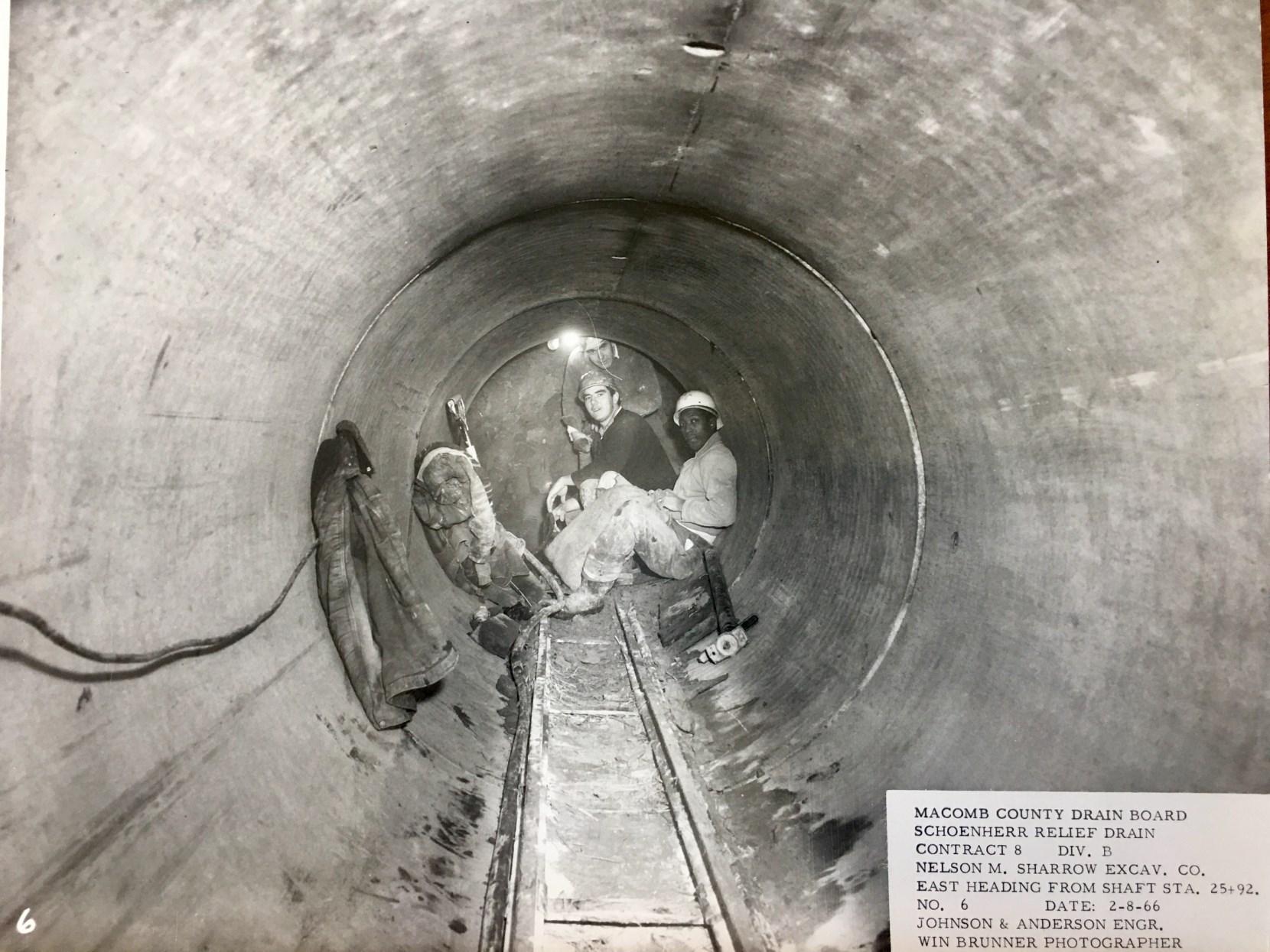
Macomb County Public Works Annual Report 2017
Candice S. Miller, Commissioner
Enhancing quality of life & economic prosperity in Macomb County
Enhancing quality of life & economic prosperity in Macomb County








Candice S. Miller, Commissioner
Enhancing quality of life & economic prosperity in Macomb County
Enhancing quality of life & economic prosperity in Macomb County






Dear neighbors,
When I first decided to run to become your public works commissioner, I had two goals: clean water and clean government. I believe we have made great strides on both fronts as we seek to transform the Public Works Office into an agency that both enhances the quality of life in Macomb County and supports economic prosperity in our communities.
Obviously, our office – and some half a million county residents – started the year in crisis mode, responding to the collapse of the 11-foot diameter sewer interceptor that runs under 15 Mile Road in Fraser. While you will find details of that project later in this annual report, I would like to highlight two aspects of that work that matter the most to the ratepayers who are ultimately responsible for the cost of that project: We are getting it done on time and under budget. Along the way, we have averted any significant environmental impact to the Clinton River or other local waters. While the final work on the site is still being wrapped up at this writing, sewage is once again passing through the underground interceptor. Many, many people, both staff and contractors, worked incredibly hard to get us to his point. My hat is off to you all.


the digging of the repair shaft in early June. BELOW: Being briefed at the site of the repair in August.

While the collapsed sewer interceptor consumed much of our focus, particularly in the early part of the year, that did not prevent us from engaging in what should always be central to our work: Cleaning out the drains of Macomb County. As you may know, this office was originally called the drain commission and taking care of the drains – small streams and creeks, as well as underground pipes – is central to what we do. This work was done at minimal levels, if at all, over the past 20plus years. Our crews have been clearing out beaver dams and other blockages all over the county to improve the flow and reduce flooding. When the drains work properly, soil erosion is minimized and the waterway is cleaner and healthier.
We’ve also been working with both federal and local partners on several projects funded by Great Lakes Restoration Initiative grants. Each of these projects – the McBride Drain in Macomb Township, the Gloede Drain in Clinton Township and the Clinton River Spillway in Clinton and Harrison townships –enhance wildlife habitat, improve the flow of the drain, remove invasive species and take other steps that enhance the natural health of the water, all of which eventually empties into Lake St. Clair.
does. We routinely meet with local mayors, township supervisors, the Michigan Dept. of Environmental Quality, the Army Corps of Engineers, the Environmental Protection Agency, leaders from surrounding communities and state legislators. Always the question is the same: Is there a way that by working together we can better protect our Great Lakes and spur local economic activity? We will continue to actively work with any partner dedicated to these goals.
Working together, we have accomplished much since I became your public works commissioner in January. Together, we will to take steps to enhance the quality of life and economic prosperity in Macomb County. If you ever have any questions or would like more information about your public works office, please do not hesitate to contact my office, visit our web site or follow us on our social media channels.
STORM DRAIN INSPECTIONS: Eastpointe Mayor Suzanne Pixley and Commissioner Miller at the site of an illicit drain connection discovered in that city. Public Works is inspecting three major storm drains in Eastpointe, Roseville & St. Clair Shores for the first time since they were installed in 1960 — to ensure the integrity of the pipes and to look for sources of pollution. The storm drains all empty in Lake St. Clair.


CLEAN THE DRAINS: Drains in the county have had little to no maintenance in recent decades, allowing logs, trash and other debris to block the flow of water, such as this obstruction on the Harrington Drain in Clinton Township — often causing local flooding. Public Works, independently and in conjunction with local units of government, will have cleaned more than 40 major drains of such blockages in 2017.
EMERGENCY PROTOCOLS:
The Public Works Office has worked with fire departments and other agencies to create a new protocol to deal with spills in the drains or other emergencies. To report an issue, call 877-679-4337


ANTI-RAGGING CAMPAIGN: The Public Works Office has created videos, encouraged media coverage and mailed more than 110,000 flyers to residents to educate the public about “ragging” problems caused in sewer systems when items such as wipes, paper towels or other items are flushed down the toilet, clogging sewer lines and binding up pumps. Only toilet paper should be flushed down the toilet.
The Macomb County Office of Public Works plays a key role in the quality of life in Macomb County. Key among the office’s responsibilities are maintaining local waterways to prevent flooding and ensuring that the waterways are protected so that they can be enjoyed not only by today’s residents but also by generations yet to come. Through the leadership of Commissioner Candice Miller, the office has made improving the overall health of Lake St. Clair an overarching priority in all of the office’s activities.
The Office of Public Works oversees two multi-community systems that collect sanitary sewage and deliver it to the Great Lakes Water Authority wastewater treatment plant in Detroit. The two systems – the Macomb Interceptor Drain Drainage District and the 8 ½ Mile Relief Drain Drainage District – serve well over half a million people in 14 Macomb County communities. Commissioner Miller has initiated a series of meetings with the leaders of these communities, as well as communities in northern Macomb County, to discuss long-term goals and to find possible areas where partnerships can benefit the communities. In 2017, the Public Works Office completed the first large-scale cleaning of the Martin Retention Basin in St. Clair Shores in more than 20 years and launched new proactive inspection initiatives of numerous wastewater facilities in the county. The office also refinanced $90 million in debt in the MIDD system, saving ratepayers more than $6 million in interest over the next 18 years.


Public Works activities can be grouped into four basic categories:

The office conducted a complete forensic audit of all financial practices. As a result of this audit and other reviews, Commissioner Miller restructured the office’s relationships with legal counsel, changed the policy regarding the use of countyowned vehicles, reinitiated regular monthly meetings of numerous drain boards and other actions, resulting in savings in excess of $1 million. Three unused parcels of land, including one at the corner of M-59 and Garfield Road, have been listed for public sale. The office is nearing completion of $8.8 million of restoration work on two drains and the Clinton River Spillway funded by the Great Lakes Restoration Initiative. The office has created a series of videos designed to educate the public on the work of the office. These videos are shared with local community cable TV stations and are available via social media.

The Public Works Office manages about 900 drains in the county. About half of these are open drains – some appearing as small creeks or streams, others are ditches that only fill after a rainfall. The other half are enclosed drains underground pipes generally found in older communities. All of these storm drains eventually transfer water to Lake St. Clair. The Public Works Office has launched a new drain maintenance program to remove beaver dams, trash and other debris from the open drains, in order to allow water flow to move without hindrance. This effort reduces soil erosion and reduces localized flooding. In the enclosed drains, inspection and testing efforts are ensuring the integrity of the pipes and making certain that sanitary sewage is not entering the drain – and ultimately ending up in Lake St. Clair.


The office restructured the review process for building plans, streamlining the process and reducing waiting times for developers. The office has created a new engineering coordinator position to give contractors, governmental agencies and other organizations a single point of contact for all initial inquiries.

On Christmas Eve morning 2016, a 300-foot by 28-foot sinkhole developed under 15 Mile Road in Fraser, between Utica and Hayes roads, after an 11-foot diameter sewer interceptor collapsed.
The sewer interceptor, 60 feet below the surface of the road, is a key artery in the Macomb Interceptor Drain Drainage District’s (MIDD) waste water system which carries sanitary sewage from 11 Macomb County communities – nearly half a million people and more than 40,000 businesses – to a treatment plant in Detroit. Immediately, Fraser and neighboring Clinton Township declared an emergency, an action that was quickly followed by both the county and the state.
Two days after Christmas, the sewer system was overloaded and 13 million gallons of sewage was pumped into the Clinton River to prevent it from backing up into people’s homes.
The initial steps of responding to the sewer collapse crisis was hampered by the absence of the previous Macomb County Public

Works Commissioner and his senior staff. On Jan. 1, 2017, newly-elected Public Works Commissioner Candice Miller took office and met with work crews at the site and began coordinating the overall response and repair process.
Quickly, crews worked to install a small pipe, about a foot in diameter, to allow some relief for the sewage that could not get through the collapse. A stop-gap measure, this initial pipe was eventually replace by a massive sewer by-pass pumping system. This system created a detour around the collapsed pipe to allow the sewage to continue to flow during the repair process. Costing about $13 million to create, the by-pass system involved eight pumps and more than a mile of above ground pipe, most of it about 4 ½ feet in diameter. The by -pass system carried the sewage around the damaged part of the line, providing enough room for the repair – and preventing the need for another emergency dump of sewage into the river.
Commissioner Miller’s charge to
the crews was clear from the moment she took office: We will work day and night to protect the Clinton River during this emergency.
During the initial emergency, a small neighborhood of 23 homes had to be evacuated for Christmas and about two weeks thereafter. While 20 of those families were eventually able to return to their homes, three of the homes were condemned and two had to be demolished as a result of the sinkhole. Those families were all reimbursed by the MIDD for their expenses and losses.
Once the by-pass was in place in late spring 2017, the repair process could begin. To begin the process, a massive 12foot deep “shelf” was dug. Then, using a series of cement and steel beams that were drilled down 70 feet into the ground, a retaining wall was created around the damaged pipe. With this wall in place, the repair shaft was dug – 65 feet deep, 300 feet long and 28 feet wide a football field sized excavation about six stories down.
At the same time, the MIDD launched a $1.5 million inspection of the entire MIDD system. Utilizing sonar, visual inspections, floating cameras and other tools, engineers were able to target areas of the MIDD for future repair. As part of that inspection, it was determined that 3,700 feet of pipe immediately east of the collapse on 15 Mile was in imminent danger of collapse.
Replacement pipe, made from a new fiberglass and cement polymer, was trucked in from Texas. This new pipe, 9-feet-2inches in diameter, would fit inside the 3,700 feet of compromised pipe and would replace the 300 feet of collapsed pipe. The pipe was installed via crane and specialized equipment

Commissioner Miller, County Executive Mark Hackel and others brief Gov. Rick Snyder during an early January visit to the sewer collapse site.
in the late summer and early fall.
At the time of this publication, the project was on target to be completed by the end of 2017, with 15 Mile Road resurfaced and all services in that area restored.
The total project was initially expected to cost about $75 million to complete. The MIDD board sold a municipal bond for $70 million and received more than $5 million in state funding to finance the project. At this writing, the final tally of expenses is not complete, but it is expected that the repair project will come in well under budget.
As the repair work was beginning, Commissioner Miller directed county engineers to engage in a comprehensive inspection of all MIDD assets, using both visual inspections and sonar testing around pipe beds. A final report on that effort is due in early 2018.



As part of the Macomb County Bicentennial Celebration, the Public Works Office has been reviewing a number of old files for possible display. In this image from 1966, three men are taking a break while hand-digging a shaft of the Schoenherr Relief Drain, 60 feet below the surface, in Warren. The office of the Macomb County Drain Commissioner was established in 1906 when Fremont C. Hains of Shelby Township was elected as the county’s first drain commissioner. The Public Works Office recently received a state grant to inspect the Schoenherr Relief Drain to ensure the integrity of the pipe and check for any possible illicit sanitary sewer connections. That work will begin in late 2017. It will be the first such inspection of the drain since it was constructed.